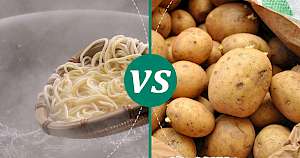Potato vs Pasta: Make Healthy Choices
Where is more calories, protein, carbs - what is more healthy?


Cooked pasta vs Potato: Nutrition Comparison
| per 100g | Potato | Pasta |
|---|---|---|
| Calories | 77 | 131 |
| Carbohydrates | 17.49 g | 24.93 g |
| Fat | 0.1 g | 1.05 g |
| Protein | 2.05 g | 5.15 g |
| Calcium | 12 mg | 6 mg |
| Iron | 0.81 mg | 1.14 mg |
| Magnessium | 23 mg | 18 mg |
| Phosphorus | 57 mg | 6 mg |
| Potassium | 425 mg | 24 mg |
| Sodium | 6 mg | 6 mg |
| Zink | 0.3 mg | 6 mg |
| Vitaminium B1 (Thiamine) | 0.081 mg | 0.209 mg |
| Vitaminium B2 (riboflavin) | 0.032 mg | 0.15 mg |
| Vitaminium B3 (Niacin) | 1.061 mg | 0.992 mg |
| Vitaminium B6 | 0.298 mg | 0.034 mg |
| Vitaminium B9 (Folic acid) | 15 mg | 0.104 mg |
Less Calories in Potato
At first glance, you can see that in potato is much less calories than in cooked pasta.
Potato has 77 kcal per 100g and cooked pasta 131 kcal per 100g so it is pretty easy to calculate that the difference is about 70%.
In potato and in cooked pasta most calories came from carbs.
See tables below to compare potato with cooked pasta in details.
Potato And Cooked pasta Nutrition Difference
- Calories:
cooked pasta - 70% more than potato - Carbohydrates:
cooked pasta - 43% more than potato - Fat:
cooked pasta - 950% more than potato - Protein:
cooked pasta - 151% more than potato
Less protein in potato
It is aslo easy to see see that in potato is less protein than in cooked pasta.
There is 5.15g per 100g of cooked pasta and 2.05g per 100g of potato so using simple math we can see that difference is about 151%.
Less carbohydrates in potato
In potato is less carbohydrates than in cooked pasta.
There is 24.93g/100g of carbohydrates in cooked pasta and 17.49g/100g in potato so let me do the math for you again - difference is about 43%.
Less fat in potato
In potato is less fats than in cooked pasta.
The tables above show us that there is 1.05g/100g of fats in cooked pasta and 0.1g/100g in potato. In this case difference is about 950%.
Potato
77kcal- Calories77
- Carbohydrates17.49 g
- Fat0.1 g
- Protein2.05 g
100g | ounce | single piece | cup | sliced
Calories source
- 88% CARBS.
- 10% PROTEIN
- 1% FAT
Pasta
131kcal- Calories131
- Carbohydrates24.93 g
- Fat1.05 g
- Protein5.15 g
100g | ounce | cup | cup | half cup
Calories source
- 77% CARBS
- 16% PROTEIN
- 7% FAT
Vitamins: cooked pasta vs potato
- Vitaminium B1 (Thiamine):
cooked pasta - 158% more than potato - Vitaminium B2 (riboflavin):
cooked pasta - 369% more than potato - Vitaminium B3 (Niacin):
potato - 7% more than cooked pasta - Vitaminium B6:
potato - 776% more than cooked pasta - Vitaminium B9 (Folic acid):
potato - 14323% more than cooked pasta
Minerals: potato vs cooked pasta
- Calcium:
potato - 100% more than cooked pasta - Iron:
cooked pasta - 41% more than potato - Magnessium:
potato - 28% more than cooked pasta - Phosphorus:
potato - 850% more than cooked pasta - Potassium:
potato - 1671% more than cooked pasta - Sodium:
cooked pasta - 0% more than potato - Zink:
cooked pasta - 1900% more than potato
Compares of potato
- Potato vs Artichoke
- Potato vs Asparagus
- Potato vs Bamboo Shoots
- Potato vs Beetroot
- Potato vs Pepper
- Potato vs Bitter Melon
- see all compares of potato
Compares of cooked pasta
Read also:
- Calories from Potato
- Calories of Pumpkin
- Calories in Purslane
- Salad chicory calories per 100g
- Radish carbs per 100g
- Rhubarb protein per 100g
- Salsify fat per 100g
- How many calories does shallot have?
- Calories in a half of corn
- Calories in whole corn
- Calories for one, two or more corn
- Calories in tablespoon of corn
- Calories in teaspoon of corn
- How much protein in sweet potato?
Marcin Piotrowicz
calories-info.com creator
Healthy diet and healthy lifestyle promoter
Add comment